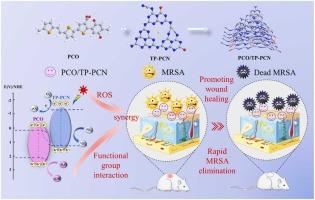Construction of a thiophene-based conjugated polymer/TP-PCN S-scheme to enhance visible-light-driven photocatalytic activity: promotion of wound healing in super-resistant bacterial infections
IF 12.2
1区 环境科学与生态学
Q1 ENGINEERING, ENVIRONMENTAL
引用次数: 0
Abstract
S-scheme heterojunctions have garnered significant attention in the field of photocatalytic antimicrobials due to their superior charge separation efficiency and higher redox capacity. In this study, an innovative linear conjugated polymer (PCO) was combined with fragmented carbon nitride (TP-PCN) to create PCO/TP-PCN organic-organic S-scheme heterojunctions, which markedly enhanced the photocatalytic antimicrobial performance. The composite (PCO-7/TP-PCN) demonstrated the ability to combat bacterial infections under visible light irradiation, effectively eradicating approximately 2.16 × 107 cfu/ml MRSA within 6 min. This exceptional photocatalytic performance can be attributed to the successful formation of an S-scheme heterojunction between PCO and TP-PCN, as well as the interaction of surface functional groups of PCO-7/TP-PCN with bacteria. Results from UV–Vis-NIR DRS and in situ-XPS experiments indicated a significant enhancement in carrier transport rate through the establishment of a built-in electric field and energy band bending at the interface. In vitro and in vivo experiments further demonstrated that PCO-7/TP-PCN not only exhibited potent antimicrobial activity under visible light irradiation but also promoted angiogenesis to inhibit inflammatory responses. Therefore, it can be concluded that this organic-organic S-scheme heterojunction photocatalyst holds great potential for development as a promising new generation of efficient antimicrobial materials, which could aid in preventing bacterial infection of wounds and ensuring effective wound healing.

求助全文
约1分钟内获得全文
求助全文
来源期刊

Journal of Hazardous Materials
工程技术-工程:环境
CiteScore
25.40
自引率
5.90%
发文量
3059
审稿时长
58 days
期刊介绍:
The Journal of Hazardous Materials serves as a global platform for promoting cutting-edge research in the field of Environmental Science and Engineering. Our publication features a wide range of articles, including full-length research papers, review articles, and perspectives, with the aim of enhancing our understanding of the dangers and risks associated with various materials concerning public health and the environment. It is important to note that the term "environmental contaminants" refers specifically to substances that pose hazardous effects through contamination, while excluding those that do not have such impacts on the environment or human health. Moreover, we emphasize the distinction between wastes and hazardous materials in order to provide further clarity on the scope of the journal. We have a keen interest in exploring specific compounds and microbial agents that have adverse effects on the environment.
 求助内容:
求助内容: 应助结果提醒方式:
应助结果提醒方式:


